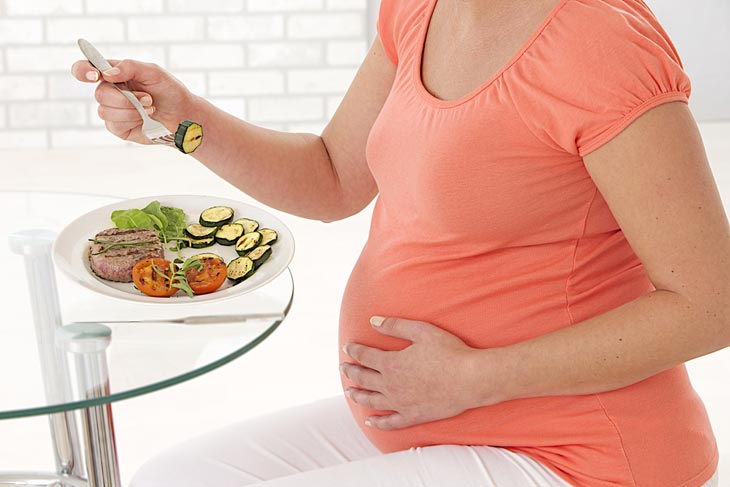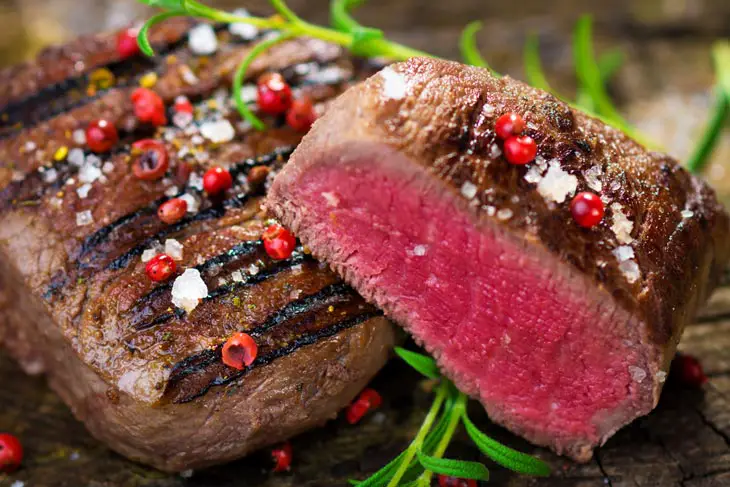High-quality diets are among the most secure ways to protect both moms and their growing babies.
But here lies one tricky problem: not all foods are suited to consumption during this critical period.
And steak is indeed one of the most controversial dishes here. Can pregnant women eat medium rare steak cuts?
Our guidelines will shed more light on the intake of med rare steak while pregnant. Let’s dive in for more tips and insights!
Can Pregnant Women Eat Medium Rare Steak?

Is medium rare steak safe for pregnancy? No, unless it is thoroughly cooked with no traces of pink color and blood.
Raw meat is packed with the toxoplasma parasite, which may make you infected, ill, and even harm your fetus.
NHS reports confirm that well-cooked meat spreads are safe for most expectant mothers, including octopus (despite its mercury level), steaks, chicken, hog, cattle, birds, sausages, and burgers.
They are an excellent source of protein and vitamin C.
On the contrary, avoid raw meat or undercooked animal cuisines.
NHS also strongly cautions against liver derivatives, pate varieties (including vegetarian paté), and game meats such as geese, partridge, or pheasant.
Why Can’t You Eat Medium Rare Steak When Pregnant?
Concerns about undercooked meat during pregnancy have always been a pressing issue.
Studies have revealed their alarming susceptibility to microbial infection, as these dishes are nutrient-dense and serve as a perfect environment for harmful bacteria to colonize.
The infection might occur at different processing stages, such as bleeding, peeling, evisceration, and washing.
Improper storage and delivery also lead to germ contamination that causes foodborne illness.
These toxic elements breed a high level of Toxoplasmosis, which results in a risk of food poisoning, muscle pain, and cracked or dry nipples during pregnancy.
Worse, they might hamper your growing babies: liver products contain excessive vitamin A, a beneficial nutrient for most humans but not yet safe for an unborn fetus, according to the NHS.
Lead hidden in game meats even causes premature destruction as well.
Fortunately, as we have established right from the beginning, a well-done piece of steak can easily alleviate those issues.
How so? American scientists have conducted a 2019 study of lamb steaks’ microbiological composition in several degrees.
The findings established that the number of harmful substances dropped from high (in raw medium steaks) to almost undetectable in fully-cooked dishes.
Remember that these critical discoveries apply to other types of meat as well, not just rare steak pregnant.
For similar cuisines like beef or pork, the NHS also advises well-cooked delicacies only.
What Are Some Critical Tips for Safe Consumption of Steaks During Pregnancy?
The key to success lies in three fundamental rules:
- “No Pink” Rules
- “Steaming Hot” Rules
- Internal Temperature Rules
Now that we have done away with the headache-inducing question, Can a pregnant woman eat a medium steak?, let’s explore the most crucial facet – safe eating tips.
1. “No Pink” Rules
Despite some finding differences in certain regards, most major organizations come to a mutual agreement upon the “No Pink” rule.
Pregnant moms should only consume cooked foods with no visible redness in the middle.
2. The “Steaming Hot” Rules
This rule might be much easier to carry out with the help of a high-quality food thermometer. But if you do not have one, no worries; there are other manual methods.
Make sure these steaks are piping hot, with no lukewarm or chilly part remaining.
To tackle those frigid cuts, place the dish in an oven for one minute or until the middle layers exude noticeable steam.
3. The Internal Temperature Rules
Never disregard USDA recommendations for cooking temperature levels. Your steaks should never get served at below 145 degrees Fahrenheit.
Instead, raise the heating to a safe temperature of 160 degrees Fahrenheit for optimal safety.
This vital rule also applies to steak-related burgers and tuna salads. A special case is the ground beef burger, which must undergo a temp of at least 170 degrees Fahrenheit.
Otherwise, any lower heating ranges might cause unsafe food consumption.
How Should Steak Be Cooked Pregnant? Some Cooking Tips
Here are seven tips any cook should bear in mind:
- Clean your hands
- Clean your counters
- Take precaution steps against contaminations
- Keep the meats frozen until ready to cook
- No tasting allowed
- Store cooked steaks in a temperature-controlled location
- Check the interior temperature before eating
1. Clean Your Hands
Hand hygiene is the first step to thorough protection against foodborne diseases. Wash your hands with cold water and soap for at least 15 to 20 seconds.
2. Clean Your Counters
Most chronological diseases stem from persistent bacteria that reside on your kitchen countertop.
Before proceeding to any cooking measures, clean them with antiseptic ointments and give these furnishings some time to full-dry.
3. Take Precaution Steps against Cross-Contaminations
During your meal preparation, always keep veggies, meats, and other equipment separate from each other.
To minimize cross-contamination with germs and pathogens, never chop your steaks next to veggies (or use the same chopping board for multiple recipes).
4. Keep The Meat Frozen Until Ready to Cook
Always store raw meat in the refrigerator until it is ready to be cooked. Refrigerated foods are less inclined to foster bacterial growth.
5. No Tastings Allowed
Never sample a cooking steak or uncooked meat. Even a slight taste of the ground beef sauce is far from a smart move!
Harmful bacteria might still thrive in these dishes until they reach at least 160 degrees Fahrenheit.
6. Store Cooked Steaks In A Temperature-Controlled Location
Correct storage plays a critical role for those who wish to keep some leftovers for further use.
You may count on slow cookers or microwaves to keep them warm for at least one or two hours. Other approaches will require thorough reheating before consumption.
For longer periods (such as a day), refrigeration is a must. Never keep steak at room temperature for more than 1 hour.
It will sustain an ideal environment for growing germs and diseases.
7. Check The Interior Temperature Before Eating
Before any immediate ingestion, ensure the dish has an interior temperature of at least 145 degrees (or moderate crispiness, but ideally 165 degrees Fahrenheit).
The easiest approach is to check for visible pink or red layers, which are not supposed to appear at this level of doneness.
Conclusion

Can pregnant women eat medium rare steak? This article has given you some pointers.
Keep in mind our tips for safe cooking and consumption, securing the best health conditions for you and your baby!
For more support, feel free to reach out to us.
